On the occasion of the Day of Entrepreneurs, on August 20, the Fourth Dialogue between President Shavkat Mirziyoyev and entrepreneurs took place in the Republic of Karakalpakstan. 300 entrepreneurs and investors from all regions participated in Nukus. 3,000 business representatives participated from regional studios.
In preparation for the dialogue, the Chamber of Commerce and Industry of the Republic of Uzbekistan (CCI) launched the electronic platform "Open Dialogue with Entrepreneurs." A Republican Commission for Organizing Dialogue with Entrepreneurs and expert working groups were established to study and resolve the problems of entrepreneurs in the regions.
At the same time, CERR, together with the CCI, conducted a large-scale study to assess entrepreneurial activity and study systemic problems. The purpose of the study was to determine the structure and dynamics of entrepreneurial activity in the country, as well as the main directions of development for further business support in the country.
Based on these assessments, the head of state announced initiatives regarding business support. A new agenda for reforms in the field of entrepreneurship in the country was formed.
The results of the linguistic analysis of the head of state's speech (from the original language) showed what the President focused on in terms of the key problems facing entrepreneurs, among which the need to reduce barriers to doing business and obstacles related to infrastructure, access to land resources and electricity stand out.
In total, the head of state used 4912 words in his speech. The most frequently used words were "entrepreneur", "enterprise", "services", "export", "market", "land", "bank", "products", "business", "project", "region" and "system". These words emphasize the relevance of the issues discussed and the need for a comprehensive approach to their solution to stimulate economic growth and improve the business climate.
Figure 1. Cloud of the most used words
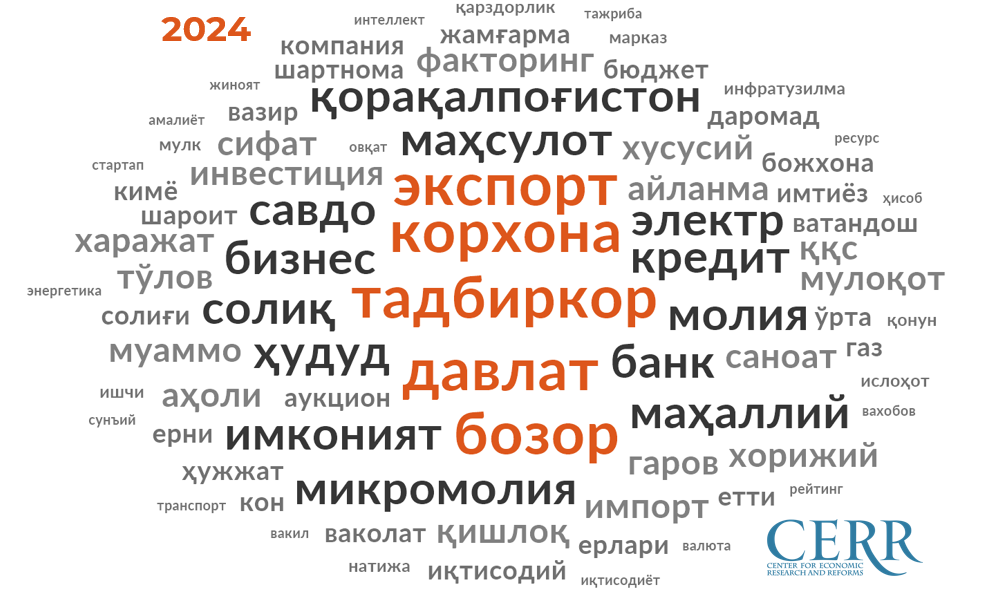
In particular, the word "entrepreneur" was mentioned 103 times, "enterprise" 47 times, "land" 41 times, "services" 28 times, "export" 26 times, "market" 25 times, "bank" 23 times, "products" and "business" 20 times each, "project" 19 times, and "region" and related words 18 times (Figure 1).
Special attention was paid to a number of key phrases. Two-word phrases such as "production" were mentioned 8 times, while "agriculture" was mentioned 7 times. The phrases "foreign market" and "microfinance organizations" were uttered 6 times, while "open dialogue," "large enterprises," and "private sector" were mentioned 5 times.
Phrases consisting of three words, including "population and entrepreneurs," were mentioned three times, while "Chamber of Commerce and Industry," "agricultural land," "through artificial intelligence," and "transparent construction system" were used twice.
Linguistic analysis of the last three dialogues with entrepreneurs demonstrates a noticeable trend of increasing usage of key terms such as "entrepreneur," "enterprise," "services," "export," "market," and "finance." The service sector stands out particularly, where the frequency of mentions increased 3.5 times compared to 2023. The use of the word "market" increased 2.3 times, and "export" - 1.7 times. It is important to note that 52% of the employed population in Uzbekistan works in the service sector (Figure 2).
Figure 2. Comparative analysis of the most used words
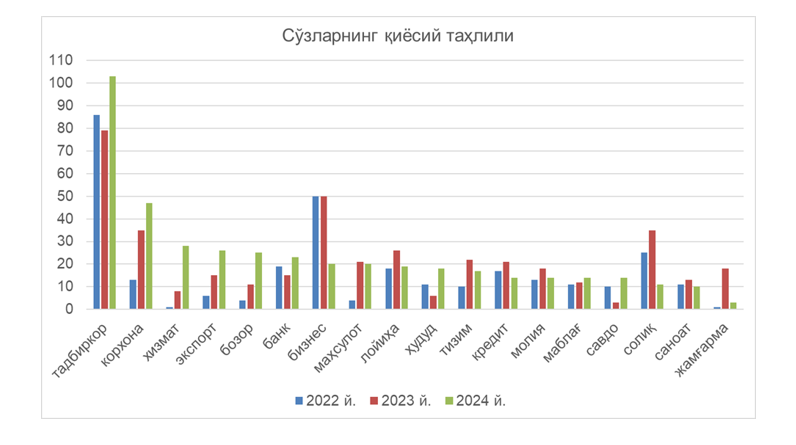
This trend indicates a shift in state policy towards the formation of a market economy. The increase in the frequency of words related to the service sector highlights the growing attention to this area, which may also indicate changing priorities in the development strategy, where services are becoming an increasingly important element of the country's economic structure.
Analysis of the President's speech by topic shows a significant distribution of emphasis on key topics, allowing us to highlight the main trends in state policy. The most attention is paid to the issues of increasing competition and expanding export opportunities, which accounts for more than 25% of the content. Reducing business barriers takes up 17% of the speech, results achieved 16%, and another 14% is devoted to supporting small and medium-sized businesses. This indicates a desire to create a more favorable business environment and move to a more liberal economic model (Figure 3).
Figure 3. Distribution of words by topic

The use of words related to infrastructure, land issues, and energy accounted for an average of about 14% of the speech, indicating the need for a comprehensive approach to economic development. These words create an association with sustainable development and long-term planning. The importance of the service sector, which accounts 14%, emphasizes the growing significance of this sector.
The sentence structure and use of introductory words create a logical connection between the stated goals and their implementation. The emphasis on protecting entrepreneurs and improving banking and credit relations also emphasizes the social responsibility of the state, which contributes to the formation of trust and willingness to interact with businesses.
Overall, the distribution of words by topic reflects a strategic course towards creating a competitive economy, where support for entrepreneurship and the development of services play a central role.
As can be seen from the graph, the President's speech touched upon a number of key areas and related issues. An analysis of the distribution of the main areas and the use of related words showed that in the field of reducing barriers to business, the most attention is paid to the words "land", "entrepreneur", "business", "bank" and "credit". These words emphasize the importance of creating a favorable environment for entrepreneurship and constitute a significant part of the speech (Figure 4).
Figure 4. Directions and the relationship of words used in them.
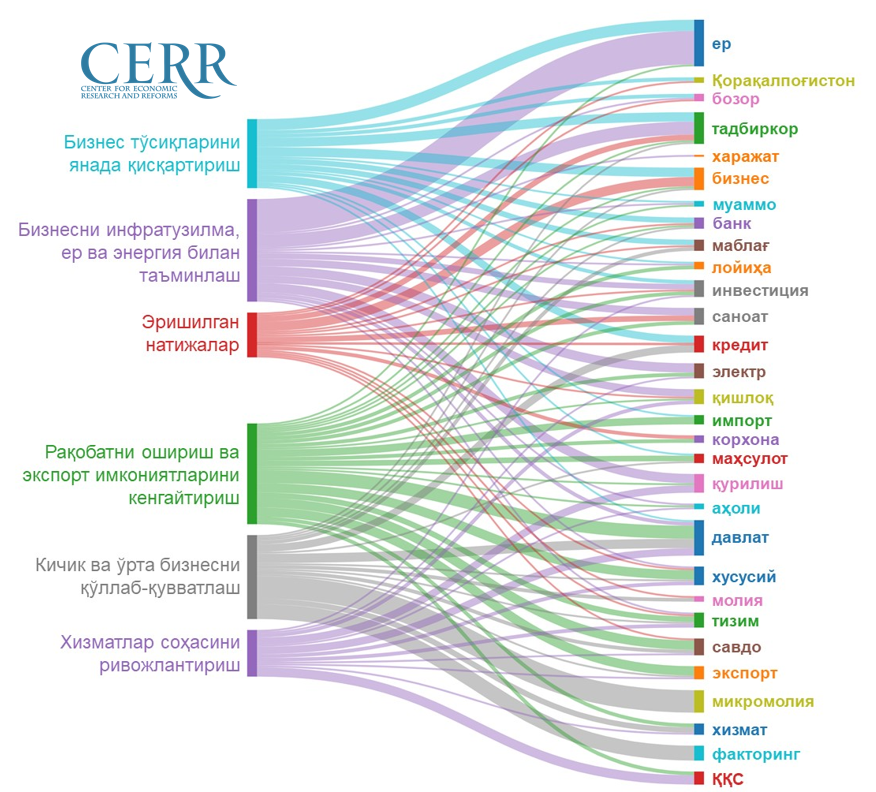
When providing businesses with resources, the keywords are "land," "electricity," "construction," "industry," "village," and "investment." These words hold a prominent place in the context of sustainable development and supporting economic growth, which also reflects the priorities of state policy.
In the section dedicated to enhancing competitiveness and expanding export opportunities, the emphasis is on the words "state," "export," "trade," "private," and "product." These terms underline the strategic goals aimed at developing foreign economic activity.
Within the framework of supporting small and medium-sized businesses, the words "microfinance," "factoring," "state," "credit," and "services" are frequently mentioned. The importance of developing the service sector is also confirmed by the use of the words "VAT," "state," "construction," "village," "system," and "private."
The President's speech demonstrates a clear structure and emphasis on key themes, highlighting his strategic approach to economic development and support for entrepreneurship.
Ilyos Rabbimov, CERR
CERR Public Relations Service


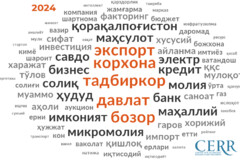
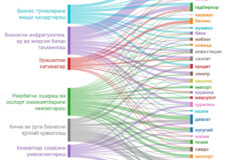
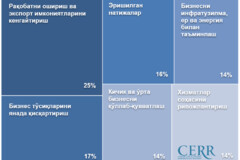



















leave a comment